Case Study Analysis: Tudor Boat Manufacturing, MGT300
VerifiedAdded on 2023/04/23
|7
|1764
|476
Case Study
AI Summary
This case study analyzes Tudor Boat Manufacturing, a family-owned Australian boat-building business facing challenges in a changing market. The analysis begins with an examination of the external macro-environment, highlighting issues like lack of innovation and increased competition. It then assesses the industry's attractiveness, identifying threats and opportunities. The internal environment is scrutinized, pinpointing issues within the company's product segment and manufacturing processes. Strategic theories are applied to understand Tudor's current strategies and their potential outcomes. The study concludes with justified recommendations for new strategies, emphasizing the need for innovation, market diversification, and strategic partnerships. The analysis also includes a detailed discussion of Porter's Five Forces and the firm's strengths and weaknesses.
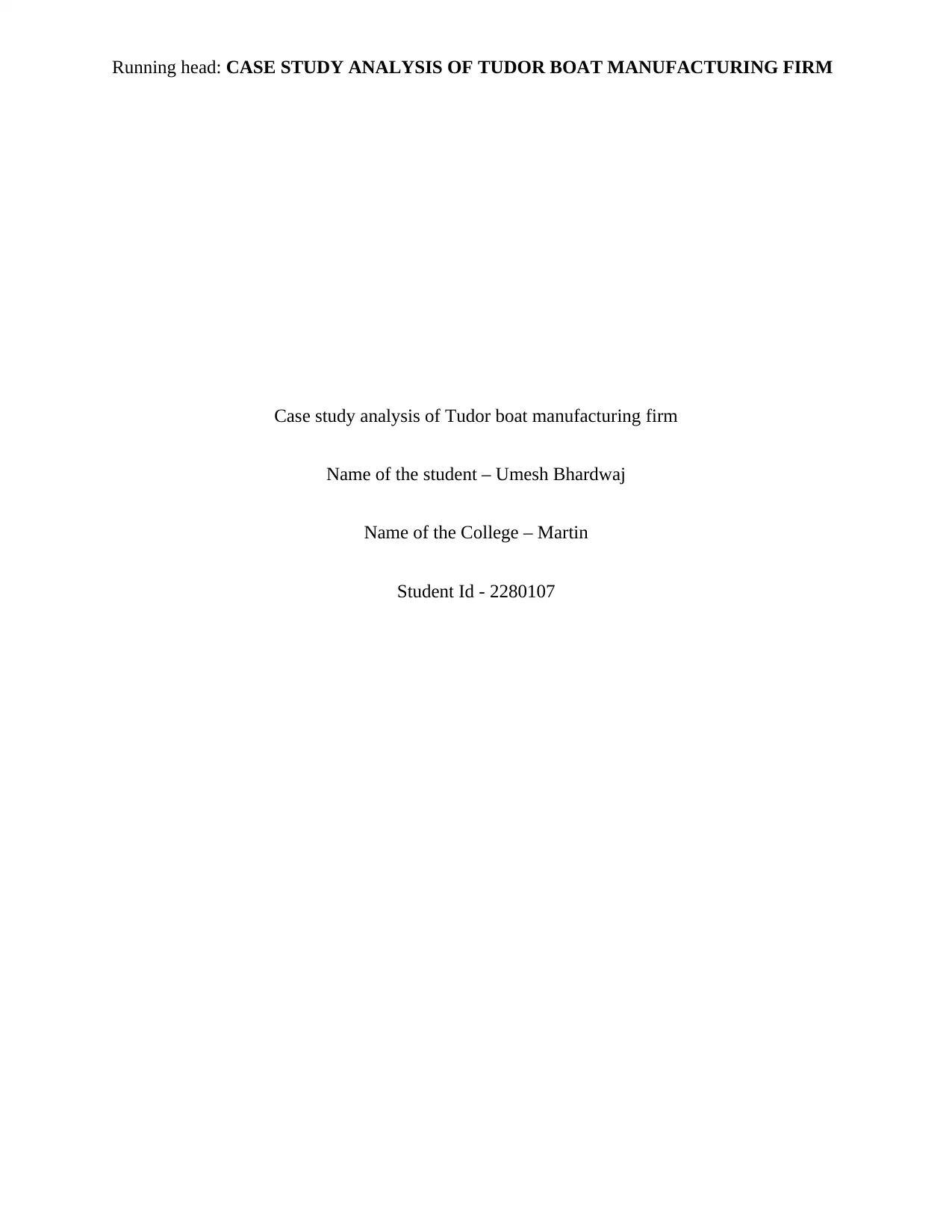
Running head: CASE STUDY ANALYSIS OF TUDOR BOAT MANUFACTURING FIRM
Case study analysis of Tudor boat manufacturing firm
Name of the student – Umesh Bhardwaj
Name of the College – Martin
Student Id - 2280107
Case study analysis of Tudor boat manufacturing firm
Name of the student – Umesh Bhardwaj
Name of the College – Martin
Student Id - 2280107
Paraphrase This Document
Need a fresh take? Get an instant paraphrase of this document with our AI Paraphraser
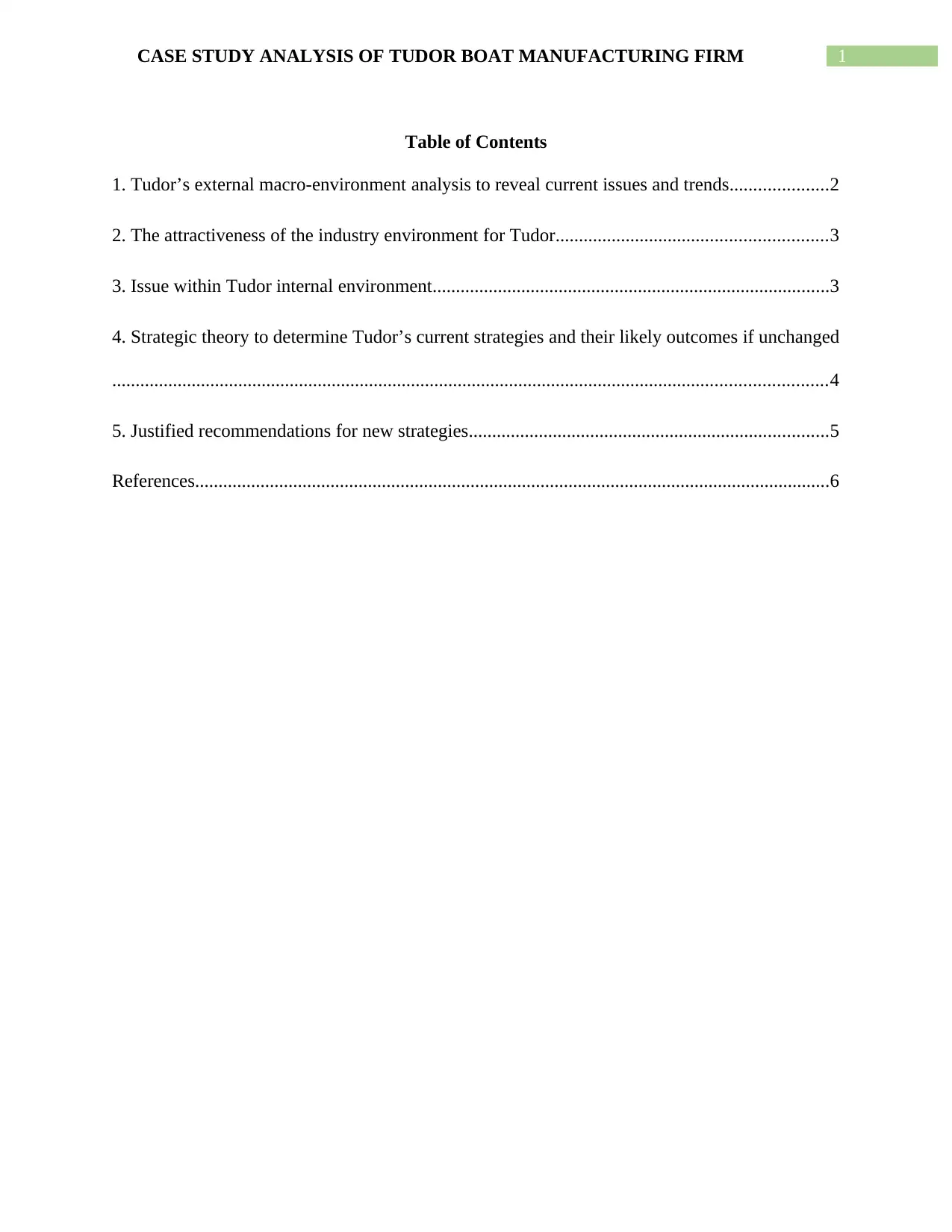
1CASE STUDY ANALYSIS OF TUDOR BOAT MANUFACTURING FIRM
Table of Contents
1. Tudor’s external macro-environment analysis to reveal current issues and trends.....................2
2. The attractiveness of the industry environment for Tudor..........................................................3
3. Issue within Tudor internal environment.....................................................................................3
4. Strategic theory to determine Tudor’s current strategies and their likely outcomes if unchanged
.........................................................................................................................................................4
5. Justified recommendations for new strategies.............................................................................5
References........................................................................................................................................6
Table of Contents
1. Tudor’s external macro-environment analysis to reveal current issues and trends.....................2
2. The attractiveness of the industry environment for Tudor..........................................................3
3. Issue within Tudor internal environment.....................................................................................3
4. Strategic theory to determine Tudor’s current strategies and their likely outcomes if unchanged
.........................................................................................................................................................4
5. Justified recommendations for new strategies.............................................................................5
References........................................................................................................................................6
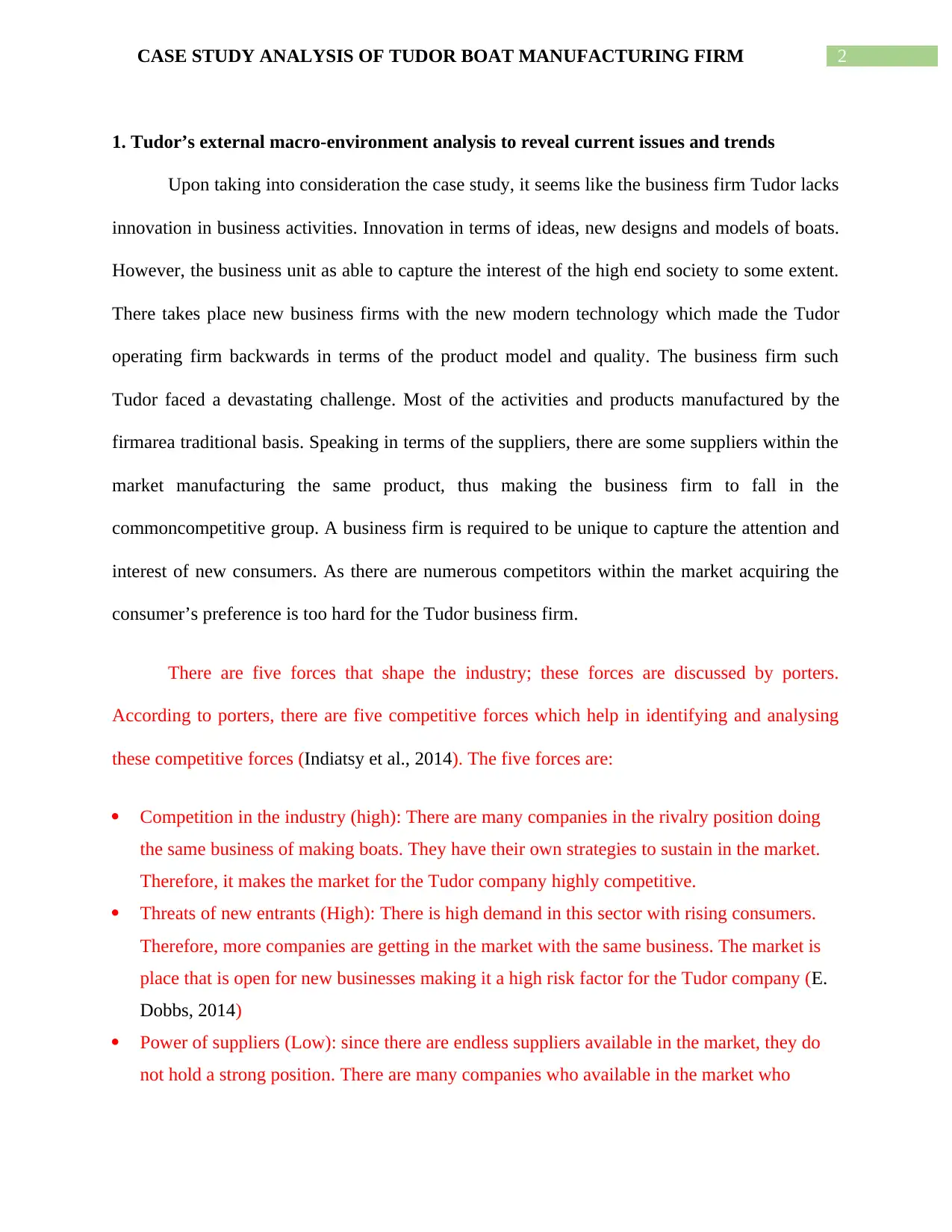
2CASE STUDY ANALYSIS OF TUDOR BOAT MANUFACTURING FIRM
1. Tudor’s external macro-environment analysis to reveal current issues and trends
Upon taking into consideration the case study, it seems like the business firm Tudor lacks
innovation in business activities. Innovation in terms of ideas, new designs and models of boats.
However, the business unit as able to capture the interest of the high end society to some extent.
There takes place new business firms with the new modern technology which made the Tudor
operating firm backwards in terms of the product model and quality. The business firm such
Tudor faced a devastating challenge. Most of the activities and products manufactured by the
firmarea traditional basis. Speaking in terms of the suppliers, there are some suppliers within the
market manufacturing the same product, thus making the business firm to fall in the
commoncompetitive group. A business firm is required to be unique to capture the attention and
interest of new consumers. As there are numerous competitors within the market acquiring the
consumer’s preference is too hard for the Tudor business firm.
There are five forces that shape the industry; these forces are discussed by porters.
According to porters, there are five competitive forces which help in identifying and analysing
these competitive forces (Indiatsy et al., 2014). The five forces are:
Competition in the industry (high): There are many companies in the rivalry position doing
the same business of making boats. They have their own strategies to sustain in the market.
Therefore, it makes the market for the Tudor company highly competitive.
Threats of new entrants (High): There is high demand in this sector with rising consumers.
Therefore, more companies are getting in the market with the same business. The market is
place that is open for new businesses making it a high risk factor for the Tudor company (E.
Dobbs, 2014)
Power of suppliers (Low): since there are endless suppliers available in the market, they do
not hold a strong position. There are many companies who available in the market who
1. Tudor’s external macro-environment analysis to reveal current issues and trends
Upon taking into consideration the case study, it seems like the business firm Tudor lacks
innovation in business activities. Innovation in terms of ideas, new designs and models of boats.
However, the business unit as able to capture the interest of the high end society to some extent.
There takes place new business firms with the new modern technology which made the Tudor
operating firm backwards in terms of the product model and quality. The business firm such
Tudor faced a devastating challenge. Most of the activities and products manufactured by the
firmarea traditional basis. Speaking in terms of the suppliers, there are some suppliers within the
market manufacturing the same product, thus making the business firm to fall in the
commoncompetitive group. A business firm is required to be unique to capture the attention and
interest of new consumers. As there are numerous competitors within the market acquiring the
consumer’s preference is too hard for the Tudor business firm.
There are five forces that shape the industry; these forces are discussed by porters.
According to porters, there are five competitive forces which help in identifying and analysing
these competitive forces (Indiatsy et al., 2014). The five forces are:
Competition in the industry (high): There are many companies in the rivalry position doing
the same business of making boats. They have their own strategies to sustain in the market.
Therefore, it makes the market for the Tudor company highly competitive.
Threats of new entrants (High): There is high demand in this sector with rising consumers.
Therefore, more companies are getting in the market with the same business. The market is
place that is open for new businesses making it a high risk factor for the Tudor company (E.
Dobbs, 2014)
Power of suppliers (Low): since there are endless suppliers available in the market, they do
not hold a strong position. There are many companies who available in the market who
⊘ This is a preview!⊘
Do you want full access?
Subscribe today to unlock all pages.

Trusted by 1+ million students worldwide
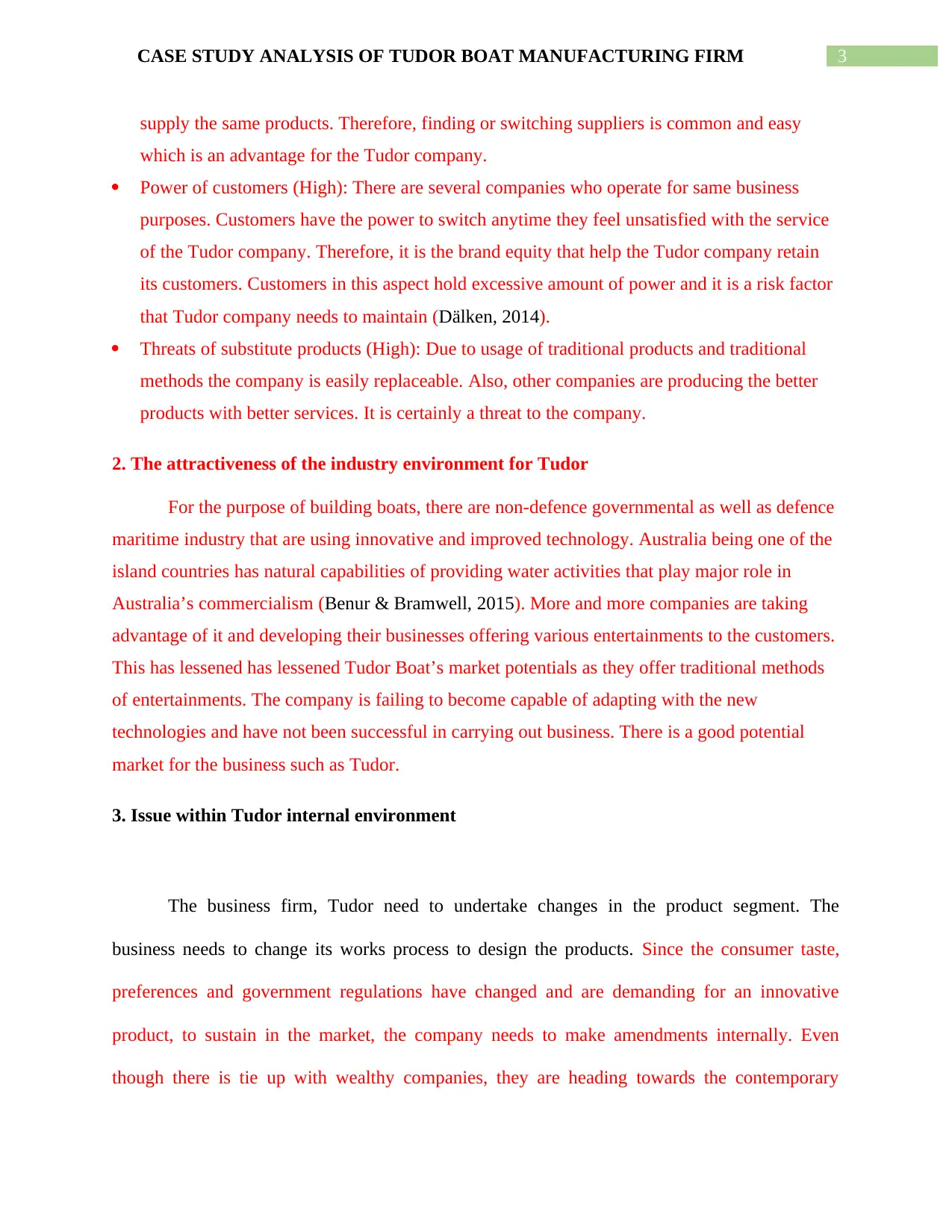
3CASE STUDY ANALYSIS OF TUDOR BOAT MANUFACTURING FIRM
supply the same products. Therefore, finding or switching suppliers is common and easy
which is an advantage for the Tudor company.
Power of customers (High): There are several companies who operate for same business
purposes. Customers have the power to switch anytime they feel unsatisfied with the service
of the Tudor company. Therefore, it is the brand equity that help the Tudor company retain
its customers. Customers in this aspect hold excessive amount of power and it is a risk factor
that Tudor company needs to maintain (Dälken, 2014).
Threats of substitute products (High): Due to usage of traditional products and traditional
methods the company is easily replaceable. Also, other companies are producing the better
products with better services. It is certainly a threat to the company.
2. The attractiveness of the industry environment for Tudor
For the purpose of building boats, there are non-defence governmental as well as defence
maritime industry that are using innovative and improved technology. Australia being one of the
island countries has natural capabilities of providing water activities that play major role in
Australia’s commercialism (Benur & Bramwell, 2015). More and more companies are taking
advantage of it and developing their businesses offering various entertainments to the customers.
This has lessened has lessened Tudor Boat’s market potentials as they offer traditional methods
of entertainments. The company is failing to become capable of adapting with the new
technologies and have not been successful in carrying out business. There is a good potential
market for the business such as Tudor.
3. Issue within Tudor internal environment
The business firm, Tudor need to undertake changes in the product segment. The
business needs to change its works process to design the products. Since the consumer taste,
preferences and government regulations have changed and are demanding for an innovative
product, to sustain in the market, the company needs to make amendments internally. Even
though there is tie up with wealthy companies, they are heading towards the contemporary
supply the same products. Therefore, finding or switching suppliers is common and easy
which is an advantage for the Tudor company.
Power of customers (High): There are several companies who operate for same business
purposes. Customers have the power to switch anytime they feel unsatisfied with the service
of the Tudor company. Therefore, it is the brand equity that help the Tudor company retain
its customers. Customers in this aspect hold excessive amount of power and it is a risk factor
that Tudor company needs to maintain (Dälken, 2014).
Threats of substitute products (High): Due to usage of traditional products and traditional
methods the company is easily replaceable. Also, other companies are producing the better
products with better services. It is certainly a threat to the company.
2. The attractiveness of the industry environment for Tudor
For the purpose of building boats, there are non-defence governmental as well as defence
maritime industry that are using innovative and improved technology. Australia being one of the
island countries has natural capabilities of providing water activities that play major role in
Australia’s commercialism (Benur & Bramwell, 2015). More and more companies are taking
advantage of it and developing their businesses offering various entertainments to the customers.
This has lessened has lessened Tudor Boat’s market potentials as they offer traditional methods
of entertainments. The company is failing to become capable of adapting with the new
technologies and have not been successful in carrying out business. There is a good potential
market for the business such as Tudor.
3. Issue within Tudor internal environment
The business firm, Tudor need to undertake changes in the product segment. The
business needs to change its works process to design the products. Since the consumer taste,
preferences and government regulations have changed and are demanding for an innovative
product, to sustain in the market, the company needs to make amendments internally. Even
though there is tie up with wealthy companies, they are heading towards the contemporary
Paraphrase This Document
Need a fresh take? Get an instant paraphrase of this document with our AI Paraphraser
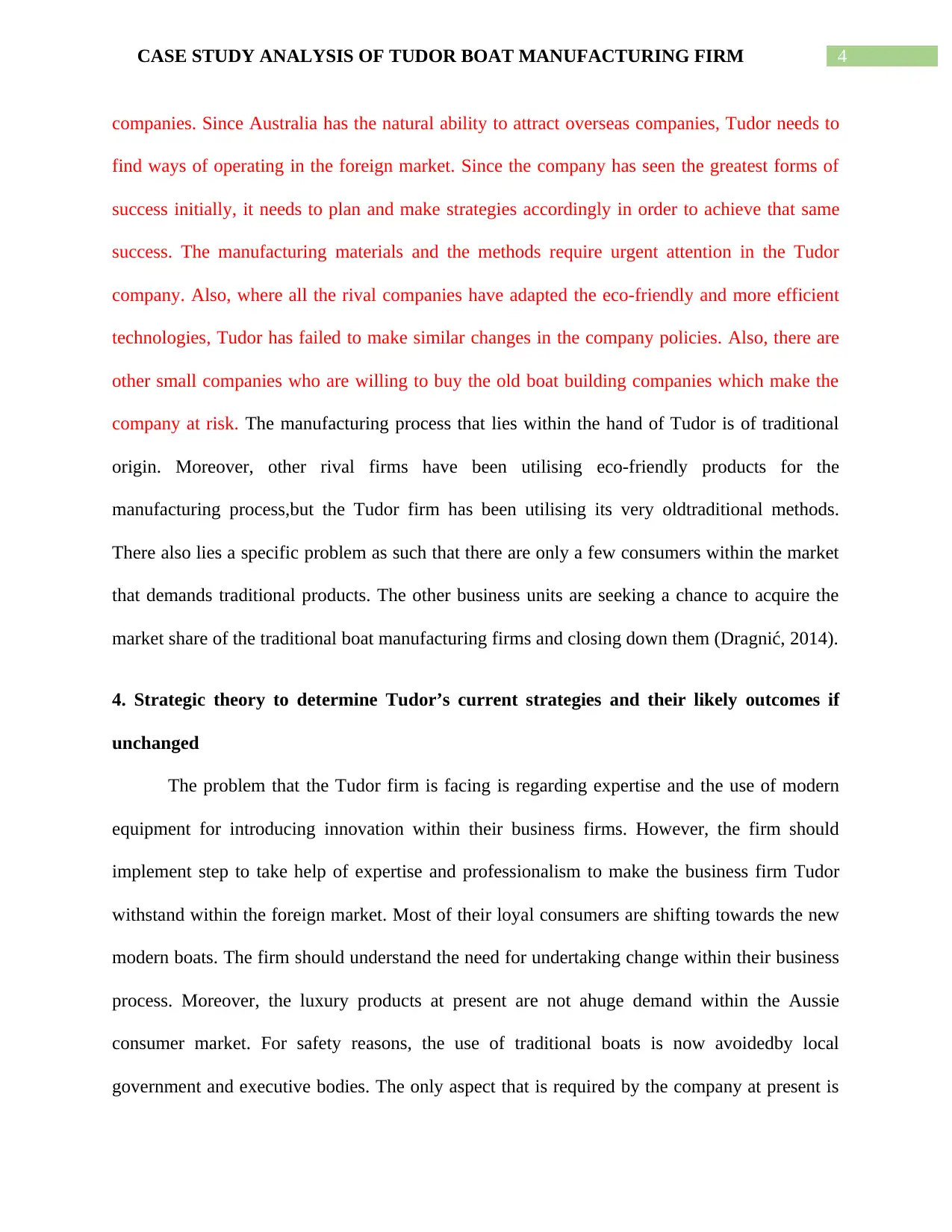
4CASE STUDY ANALYSIS OF TUDOR BOAT MANUFACTURING FIRM
companies. Since Australia has the natural ability to attract overseas companies, Tudor needs to
find ways of operating in the foreign market. Since the company has seen the greatest forms of
success initially, it needs to plan and make strategies accordingly in order to achieve that same
success. The manufacturing materials and the methods require urgent attention in the Tudor
company. Also, where all the rival companies have adapted the eco-friendly and more efficient
technologies, Tudor has failed to make similar changes in the company policies. Also, there are
other small companies who are willing to buy the old boat building companies which make the
company at risk. The manufacturing process that lies within the hand of Tudor is of traditional
origin. Moreover, other rival firms have been utilising eco-friendly products for the
manufacturing process,but the Tudor firm has been utilising its very oldtraditional methods.
There also lies a specific problem as such that there are only a few consumers within the market
that demands traditional products. The other business units are seeking a chance to acquire the
market share of the traditional boat manufacturing firms and closing down them (Dragnić, 2014).
4. Strategic theory to determine Tudor’s current strategies and their likely outcomes if
unchanged
The problem that the Tudor firm is facing is regarding expertise and the use of modern
equipment for introducing innovation within their business firms. However, the firm should
implement step to take help of expertise and professionalism to make the business firm Tudor
withstand within the foreign market. Most of their loyal consumers are shifting towards the new
modern boats. The firm should understand the need for undertaking change within their business
process. Moreover, the luxury products at present are not ahuge demand within the Aussie
consumer market. For safety reasons, the use of traditional boats is now avoidedby local
government and executive bodies. The only aspect that is required by the company at present is
companies. Since Australia has the natural ability to attract overseas companies, Tudor needs to
find ways of operating in the foreign market. Since the company has seen the greatest forms of
success initially, it needs to plan and make strategies accordingly in order to achieve that same
success. The manufacturing materials and the methods require urgent attention in the Tudor
company. Also, where all the rival companies have adapted the eco-friendly and more efficient
technologies, Tudor has failed to make similar changes in the company policies. Also, there are
other small companies who are willing to buy the old boat building companies which make the
company at risk. The manufacturing process that lies within the hand of Tudor is of traditional
origin. Moreover, other rival firms have been utilising eco-friendly products for the
manufacturing process,but the Tudor firm has been utilising its very oldtraditional methods.
There also lies a specific problem as such that there are only a few consumers within the market
that demands traditional products. The other business units are seeking a chance to acquire the
market share of the traditional boat manufacturing firms and closing down them (Dragnić, 2014).
4. Strategic theory to determine Tudor’s current strategies and their likely outcomes if
unchanged
The problem that the Tudor firm is facing is regarding expertise and the use of modern
equipment for introducing innovation within their business firms. However, the firm should
implement step to take help of expertise and professionalism to make the business firm Tudor
withstand within the foreign market. Most of their loyal consumers are shifting towards the new
modern boats. The firm should understand the need for undertaking change within their business
process. Moreover, the luxury products at present are not ahuge demand within the Aussie
consumer market. For safety reasons, the use of traditional boats is now avoidedby local
government and executive bodies. The only aspect that is required by the company at present is
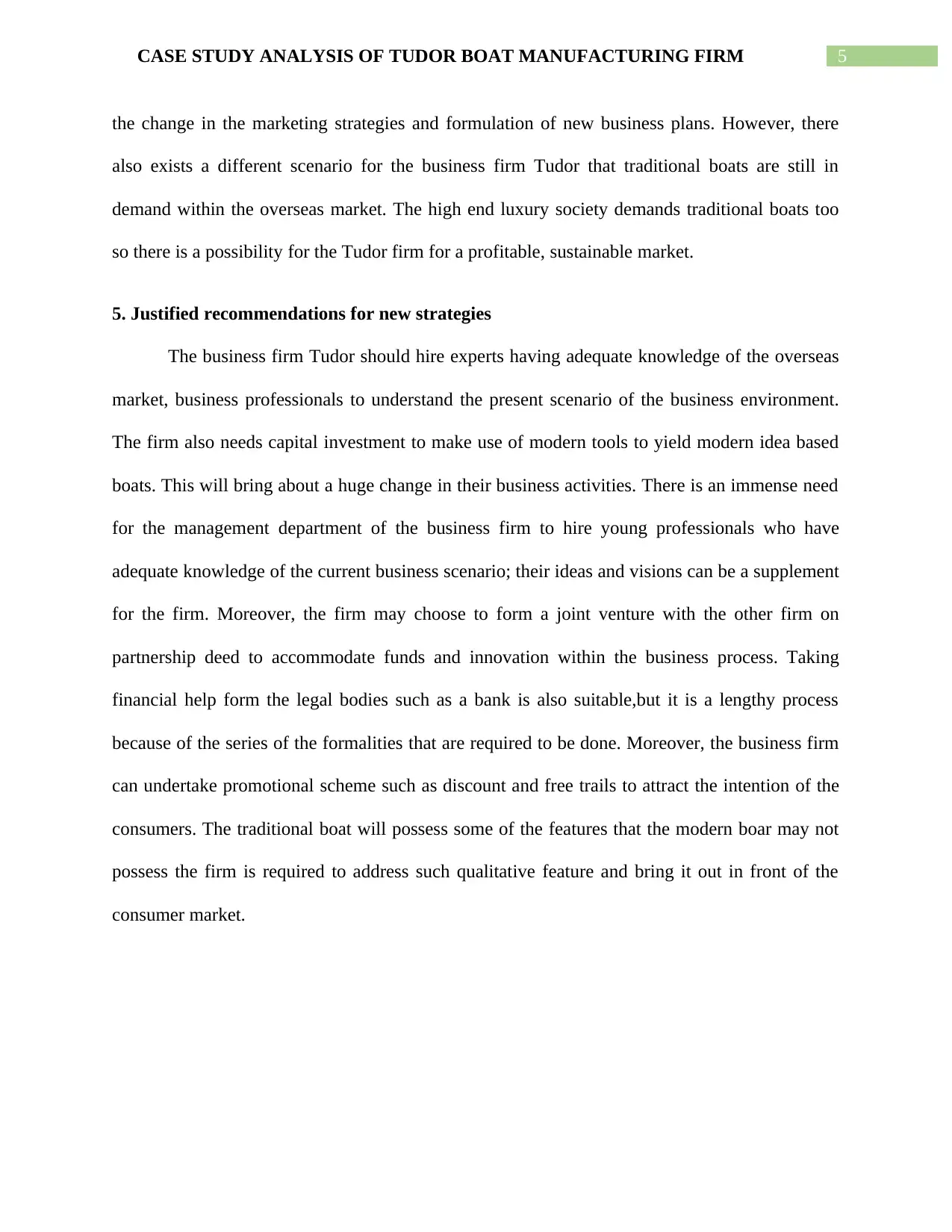
5CASE STUDY ANALYSIS OF TUDOR BOAT MANUFACTURING FIRM
the change in the marketing strategies and formulation of new business plans. However, there
also exists a different scenario for the business firm Tudor that traditional boats are still in
demand within the overseas market. The high end luxury society demands traditional boats too
so there is a possibility for the Tudor firm for a profitable, sustainable market.
5. Justified recommendations for new strategies
The business firm Tudor should hire experts having adequate knowledge of the overseas
market, business professionals to understand the present scenario of the business environment.
The firm also needs capital investment to make use of modern tools to yield modern idea based
boats. This will bring about a huge change in their business activities. There is an immense need
for the management department of the business firm to hire young professionals who have
adequate knowledge of the current business scenario; their ideas and visions can be a supplement
for the firm. Moreover, the firm may choose to form a joint venture with the other firm on
partnership deed to accommodate funds and innovation within the business process. Taking
financial help form the legal bodies such as a bank is also suitable,but it is a lengthy process
because of the series of the formalities that are required to be done. Moreover, the business firm
can undertake promotional scheme such as discount and free trails to attract the intention of the
consumers. The traditional boat will possess some of the features that the modern boar may not
possess the firm is required to address such qualitative feature and bring it out in front of the
consumer market.
the change in the marketing strategies and formulation of new business plans. However, there
also exists a different scenario for the business firm Tudor that traditional boats are still in
demand within the overseas market. The high end luxury society demands traditional boats too
so there is a possibility for the Tudor firm for a profitable, sustainable market.
5. Justified recommendations for new strategies
The business firm Tudor should hire experts having adequate knowledge of the overseas
market, business professionals to understand the present scenario of the business environment.
The firm also needs capital investment to make use of modern tools to yield modern idea based
boats. This will bring about a huge change in their business activities. There is an immense need
for the management department of the business firm to hire young professionals who have
adequate knowledge of the current business scenario; their ideas and visions can be a supplement
for the firm. Moreover, the firm may choose to form a joint venture with the other firm on
partnership deed to accommodate funds and innovation within the business process. Taking
financial help form the legal bodies such as a bank is also suitable,but it is a lengthy process
because of the series of the formalities that are required to be done. Moreover, the business firm
can undertake promotional scheme such as discount and free trails to attract the intention of the
consumers. The traditional boat will possess some of the features that the modern boar may not
possess the firm is required to address such qualitative feature and bring it out in front of the
consumer market.
⊘ This is a preview!⊘
Do you want full access?
Subscribe today to unlock all pages.

Trusted by 1+ million students worldwide
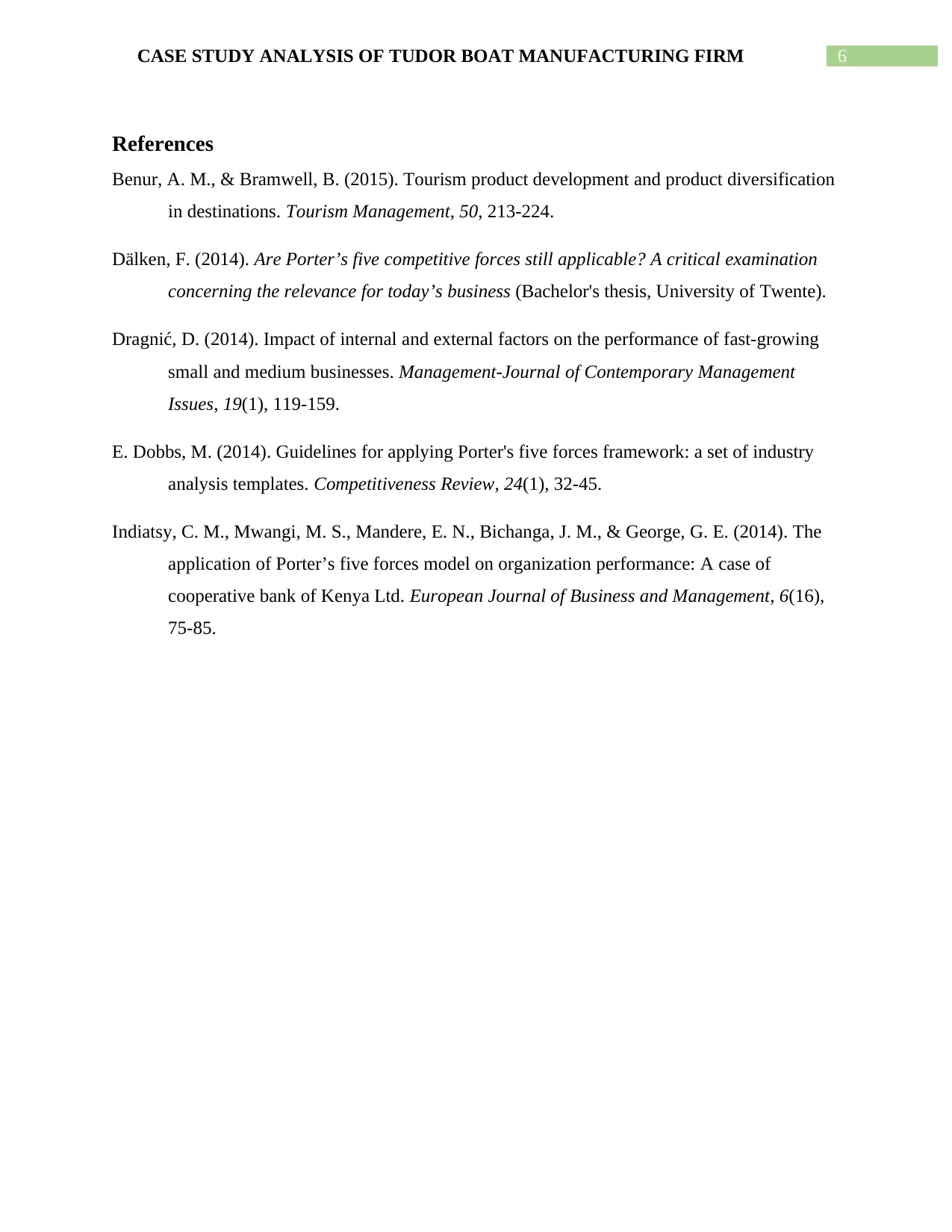
6CASE STUDY ANALYSIS OF TUDOR BOAT MANUFACTURING FIRM
References
Benur, A. M., & Bramwell, B. (2015). Tourism product development and product diversification
in destinations. Tourism Management, 50, 213-224.
Dälken, F. (2014). Are Porter’s five competitive forces still applicable? A critical examination
concerning the relevance for today’s business (Bachelor's thesis, University of Twente).
Dragnić, D. (2014). Impact of internal and external factors on the performance of fast-growing
small and medium businesses. Management-Journal of Contemporary Management
Issues, 19(1), 119-159.
E. Dobbs, M. (2014). Guidelines for applying Porter's five forces framework: a set of industry
analysis templates. Competitiveness Review, 24(1), 32-45.
Indiatsy, C. M., Mwangi, M. S., Mandere, E. N., Bichanga, J. M., & George, G. E. (2014). The
application of Porter’s five forces model on organization performance: A case of
cooperative bank of Kenya Ltd. European Journal of Business and Management, 6(16),
75-85.
References
Benur, A. M., & Bramwell, B. (2015). Tourism product development and product diversification
in destinations. Tourism Management, 50, 213-224.
Dälken, F. (2014). Are Porter’s five competitive forces still applicable? A critical examination
concerning the relevance for today’s business (Bachelor's thesis, University of Twente).
Dragnić, D. (2014). Impact of internal and external factors on the performance of fast-growing
small and medium businesses. Management-Journal of Contemporary Management
Issues, 19(1), 119-159.
E. Dobbs, M. (2014). Guidelines for applying Porter's five forces framework: a set of industry
analysis templates. Competitiveness Review, 24(1), 32-45.
Indiatsy, C. M., Mwangi, M. S., Mandere, E. N., Bichanga, J. M., & George, G. E. (2014). The
application of Porter’s five forces model on organization performance: A case of
cooperative bank of Kenya Ltd. European Journal of Business and Management, 6(16),
75-85.
1 out of 7
Related Documents
Your All-in-One AI-Powered Toolkit for Academic Success.
+13062052269
info@desklib.com
Available 24*7 on WhatsApp / Email
![[object Object]](/_next/static/media/star-bottom.7253800d.svg)
Unlock your academic potential
Copyright © 2020–2025 A2Z Services. All Rights Reserved. Developed and managed by ZUCOL.





